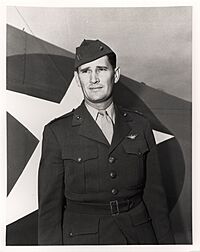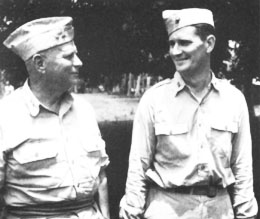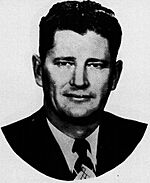Joe Foss facts for kids
Quick facts for kids
Joe Foss
|
|
|---|---|

Captain Joe Foss, U.S. Marine Corps
|
|
| President of the National Rifle Association | |
| In office 1988–1990 |
|
| Preceded by | James E. Reinke |
| Succeeded by | Richard D. Riley |
| 20th Governor of South Dakota | |
| In office January 6, 1955 – January 6, 1959 |
|
| Lieutenant | L. Roy Houck |
| Preceded by | Sigurd Anderson |
| Succeeded by | Ralph Herseth |
| Personal details | |
| Born |
Joseph Jacob Foss
April 17, 1915 Sioux Falls, South Dakota, U.S. |
| Died | January 1, 2003 (aged 87) Scottsdale, Arizona, U.S. |
| Resting place | Arlington National Cemetery |
| Political party | Republican |
| Spouses |
June Shakstad
(m. 1942; div. 1967)Donna Wild Hall
(m. 1967) |
| Occupation | American Football League Commissioner NRA President Television broadcaster Author Entrepreneur Spokesperson |
| Nicknames | "Smokey Joe", "Old Joe", "Old Foos", "Ace of Aces" |
| Military service | |
| Allegiance | United States |
| Branch/service | South Dakota National Guard (1939–1940) United States Marine Corps (1940–1946) South Dakota Air National Guard (1946–1955) |
| Years of service | 1939–1955 |
| Rank | Major (USMC) Brigadier General (ANG) |
| Unit | VMF-121 VMF-115 |
| Battles/wars | World War II |
| Awards | Medal of Honor Distinguished Flying Cross Air Medal (3) |
Joseph Jacob Foss (April 17, 1915 – January 1, 2003) was a brave United States Marine Corps major and a top fighter pilot during World War II. He earned the Medal of Honor, which is America's highest military award, for his amazing air combat skills during the Guadalcanal Campaign. After the war, he became a brigadier general in the Air National Guard. He also served as the 20th Governor of South Dakota from 1955 to 1959. Later, he was president of the National Rifle Association of America (NRA) and the first commissioner of the American Football League. Joe Foss was also a well-known television host.
Contents
Early Life and Dreams
Joe Foss was born on April 17, 1915, in a farmhouse near Sioux Falls, South Dakota. His family farm did not have electricity. When he was 12, he saw the famous pilot Charles Lindbergh and his plane, the Spirit of St. Louis. This sparked his dream of flying. Four years later, he took his first plane ride in a Ford Trimotor with a local pilot named Clyde Ice.
In 1933, a sad event changed his life. His father died after stepping on a downed electrical cable during a storm. Joe, not yet 18, helped his mother and brother run the family farm. Farming was tough due to dust storms.
Joe was determined to become a Marine pilot. He worked at a gas station to pay for college and flying lessons. He graduated from the University of South Dakota in 1939 with a business degree. While in college, he helped start a flying course and earned 100 flight hours. He also played sports like boxing and football. In 1940, he joined the Marine Corps Reserves to become a pilot.
Military Career
Becoming a Fighter Pilot
The Marine Corps accepted Joe Foss for flight school. He became a second lieutenant and a Naval Aviator. At first, he was considered too old to be a fighter pilot at 27. He was sent to photography school instead. But Joe really wanted to fly fighters. He kept asking for a transfer and practiced flying Grumman F4F Wildcat planes. Finally, he joined Marine Fighting Squadron 121 (VMF-121). In 1942, he married his high school sweetheart, June Shakstad.
Hero of Guadalcanal
In October 1942, Joe Foss and his squadron went to Guadalcanal as part of Operation Watchtower. They were there to help the Cactus Air Force fight for control of the sky. Their base was Henderson Field. Joe quickly became known for his aggressive flying and amazing shooting skills.
On October 13, he shot down a Japanese Mitsubishi Zero on his first mission. His own plane was hit, but he managed to land safely. On November 7, his plane was hit again, and he had to land in the sea. He survived!
Joe led a group of eight Wildcats, which became known as "Foss's Flying Circus." In December 1942, he got sick with malaria. He went to Australia to recover. He returned to Guadalcanal on January 1, 1943. By February 1943, his "Flying Circus" had shot down 72 Japanese planes. Joe Foss himself was credited with 26 enemy planes. This matched the record of America's top World War I ace, Eddie Rickenbacker. Joe Foss became America's first "ace-of-aces" in World War II. One of the Japanese pilots he shot down, Kaname Harada, later became a peace activist and met Joe many years later.
Joe Foss returned to the United States in March 1943. On May 18, 1943, President Franklin Delano Roosevelt gave him the Medal of Honor. Joe Foss appeared on the cover of Life magazine. He then went on a tour to help sell war bonds.
Back in Action
In February 1944, Joe Foss went back to the Pacific. He led VMF-115, flying the Vought F4U Corsair. During this time, he became friends with another Marine fighter ace, Marion Carl. He also met and flew with his childhood hero, Charles Lindbergh. After eight months, Joe Foss finished his combat service as one of America's top pilots.
He got malaria again and was sent home. In February 1945, he became an operations and training officer at Marine Corps Air Station Santa Barbara, California.
Life After the War
Air National Guard
In August 1945, Joe Foss left active duty. He started "Joe Foss Flying Service," a company that offered charter flights and flying lessons. It grew to have 35 aircraft.
In 1946, Joe Foss helped create the South Dakota Air National Guard. He became the commanding officer of the Guard's 175th Fighter-Interceptor Squadron. He was very involved in flying with the squadron. During the Korean War, he was called to active duty with the United States Air Force. He eventually became a brigadier general.
Political Career
Joe Foss campaigned for office by flying his small plane. He served two terms as a Republican in the South Dakota State Legislature. In 1955, at age 39, he became the youngest governor of the state.
As governor, he appeared on TV shows like Two for the Money and What's My Line. In 1958, he ran for a seat in the United States House of Representatives, but he lost to another wartime pilot, George McGovern.
Later Careers
American Football League Commissioner
After being governor, Joe Foss became the first Commissioner of the new American Football League (AFL) in 1959. He helped the league grow into a major professional football organization. During his seven years, he expanded the league and made important television deals. These deals helped make professional football very popular. He stepped down in 1966, just before the AFL merged with the NFL to create the Super Bowl.
Television Host
Joe Foss loved hunting and the outdoors. From 1964 to 1967, he hosted ABC television's The American Sportsman. This show took him around the world for hunting and fishing trips. Then, from 1967 to 1974, he hosted and produced his own outdoors TV series, The Outdoorsman: Joe Foss.
National Rifle Association President
In 1988, Joe Foss was elected president of the National Rifle Association of America (NRA) for two terms. He was known for speaking out about gun owners' rights. He appeared on the cover of Time Magazine in 1990, wearing his famous Stetson hat and holding a revolver.
Helping Others

Joe Foss had a daughter with cerebral palsy, a condition that affects movement. He became president of the National Society of Crippled Children and Adults, an organization that helps people with disabilities. He also supported other charities like the Easter Seals campaign and programs for young people.
The Joe Foss Institute
In 2001, Joe Foss and his second wife, "Didi," started the Joe Foss Institute. This organization works with veterans and teachers across the United States. Their goal is to teach young people about history and civics. They want to inspire kids to become informed and active citizens. The institute offers programs like "Veterans Inspiring Patriotism" and scholarship contests. Joe Foss himself visited many schools, talking to children about service, responsibility, and patriotism.
Other Honors
Joe Foss wrote or was the subject of several books, including Joe Foss: Flying Marine. He was also featured in Tom Brokaw's book The Greatest Generation, which told stories of World War II heroes. Brokaw described him as having "a hero's swagger but a winning smile."
In 1984, Joe Foss was inducted into the National Aviation Hall of Fame. He also served as president of the Air Force Association. In 2000, he was a consultant for the computer game Combat Flight Simulator 2.
Later Years and Legacy
On January 11, 2002, Joe Foss, then 86, was stopped by security at the Phoenix Sky Harbor International Airport. They found his Medal of Honor and a small souvenir bullet keychain. The incident caused a lot of discussion about airport security rules. Joe Foss said he was not upset for himself, but for the Medal of Honor. He felt people should know what it represents: "It represents all of the guys who lost their lives – the guys who never came back."
Joe Foss passed away on January 1, 2003, in Scottsdale, Arizona. He had suffered a stroke a few months earlier. Many important people attended his memorial service, including Vice President Dick Cheney and news anchor Tom Brokaw. Actor Charlton Heston also gave a tribute. Joe Foss was buried at Arlington National Cemetery.
Many places and institutions are named in his honor. These include Marine Corps Air Station Miramar Joe Foss Field, the Joe Foss Field Air National Guard Station in Sioux Falls, South Dakota, and Joe Foss High School. A bronze statue of him stands at the Sioux Falls Regional Airport. The Joe Foss Shooting Complex in Buckeye, Arizona, is also named after him.
Aerial Victories
The Marine Corps officially credits Joe Foss with 26 air victories. This means he shot down 26 enemy aircraft.
| Date | Total | Aircraft Types Claimed |
|---|---|---|
| October 13, 1942 | 1 | A6M "Zeke" destroyed (Cactus) |
| October 14, 1942 | 1 | A6M "Zeke" destroyed (Cactus) |
| October 18, 1942 | 3 | 2 A6M "Zekes" and 1 G4M "Betty" destroyed (Cactus) |
| October 20, 1942 | 2 | A6M "Zekes" destroyed (Cactus) |
| October 23, 1942 | 4 | A6M "Zekes" destroyed (Cactus) |
| October 25, 1942 | 2 | A6M "Zekes" destroyed (Cactus) |
| October 25, 1942 | 3 | A6M "Zekes" destroyed (Cactus) |
| November 7, 1942 | 3 | 1 A6M2-N "Rufe" and 2 F1M2 "Pete"s" destroyed (Cactus) |
| November 12, 1942 | 3 | 2 G4M "Bettys" and 1 A6M Zero destroyed (Cactus) |
| November 15, 1942 | 1 | E13A "Jake" destroyed (Cactus) |
| January 15, 1943 | 3 | A6M "Zekes" destroyed (Cactus) |
| 26 |
Military Awards
Joe Foss received many military awards and decorations, showing his bravery and service.
 |
|||
 |
|||
| United States Air Force Command Pilot Badge | |||||||||||||
| Naval Aviator Badge | |||||||||||||
| Medal of Honor | Distinguished Flying Cross | ||||||||||||
| Air Medal w/ two 5⁄16" Gold Star |
Combat Action Ribbon | Air Force Presidential Unit Citation w/ one bronze oak leaf cluster |
|||||||||||
| Navy Presidential Unit Citation w/ one 3⁄16" Bronze Star |
American Defense Service Medal | American Campaign Medal | |||||||||||
| Asiatic-Pacific Campaign Medal w/ two 3⁄16" Bronze Stars |
World War II Victory Medal | National Defense Service Medal w/ one 3⁄16" Bronze Star |
|||||||||||
| Air Force Longevity Service Award w/ one bronze oak leaf cluster |
Armed Forces Reserve Medal silver hourglass device |
Small Arms Expert Marksmanship Ribbon | |||||||||||
Images for kids
See Also
- List of Medal of Honor recipients for World War II
- American Football League players, coaches and contributors






